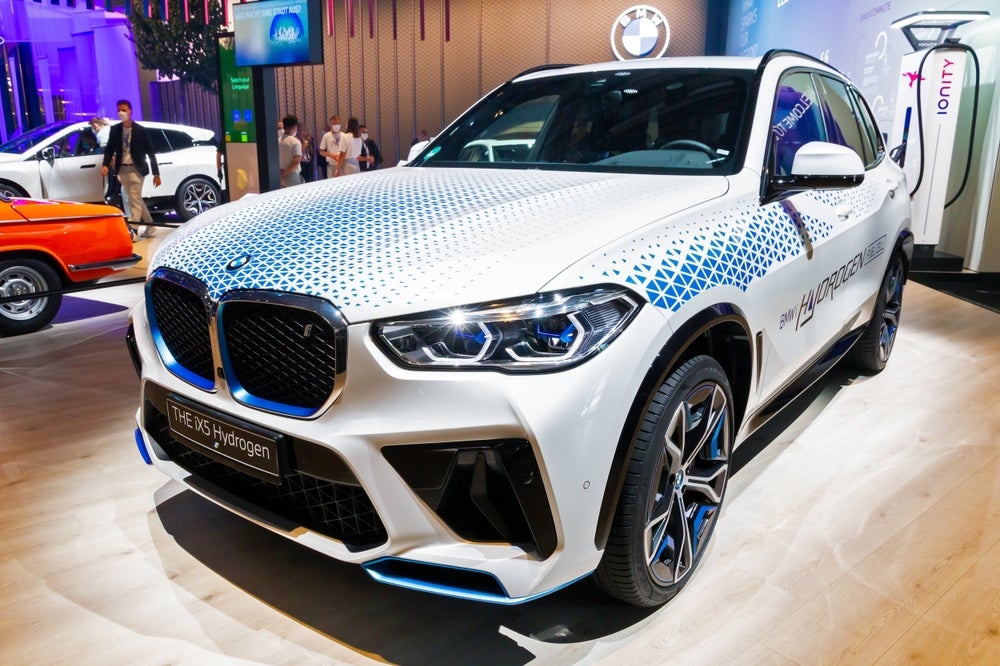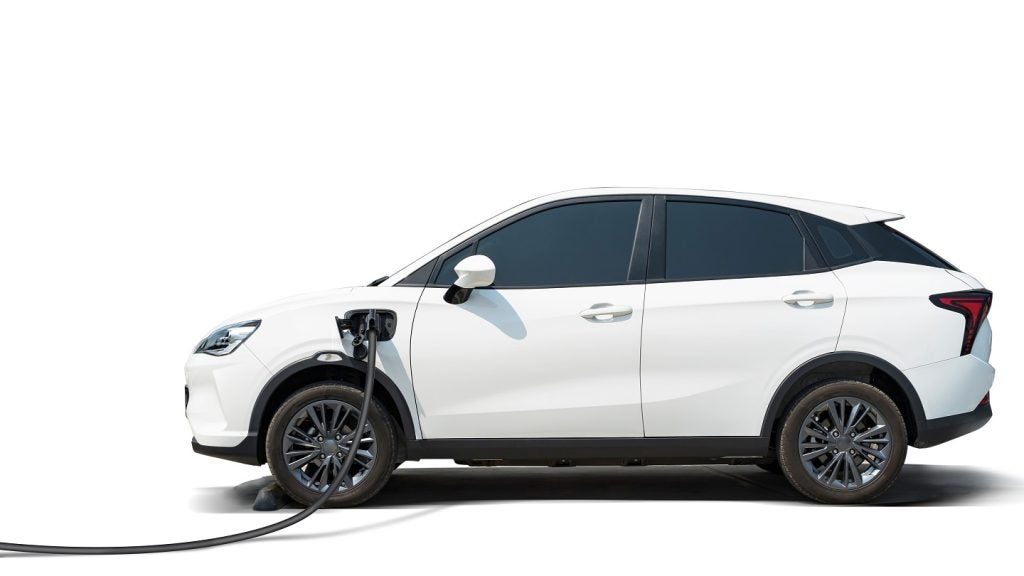How does a hydrogen car work? What is a fuel cell system? What advantages does this technology offer, and what challenges does it face? The BMW Group team answers the key questions.
How does a hydrogen drive work?
Hydrogen cars are powered by an electric motor and are therefore classified as e-cars. The common abbreviation is FCEV, short for “Fuel Cell Electric Vehicle” – in contrast to battery-powered electric cars, or Battery Electric Vehicles, BEV for short.
There is one crucial difference to other electric vehicles: hydrogen vehicles produce the electricity themselves. This means that their power does not come from a built-in battery, as is the case with purely electric vehicles or plug-in hybrid vehicles, which can be charged from an external power source. Instead, hydrogen cars effectively have their own efficient power plant on board, which converts the hydrogen in the fuel tank into electricity. And this power plant is the fuel cell.
A process known as reverse electrolysis takes place in a fuel cell. Hydrogen reacts with oxygen in the process. The hydrogen comes from one or more tanks in the car while the oxygen comes from the ambient air. The only things this reaction produces are electrical energy, heat and water, which exits through the exhaust as water vapour – with no emissions at all.
The electricity generated in the fuel cell takes two routes, depending on what the specific driving situation demands. It flows to the electric motor and directly drives the vehicle, and/or it charges a battery that acts as temporary storage until the energy is needed for the drive. This “buffer” battery is significantly smaller than the battery of an all-electric car – meaning it’s also lighter. It’s also being constantly recharged by the fuel cell.
Like other EVs, hydrogen vehicles can also recover or “recuperate” braking energy. In this process, the electric motor converts the car’s kinetic energy back into electrical energy and feeds it into the buffer battery.
How well do you really know your competitors?
Access the most comprehensive Company Profiles on the market, powered by GlobalData. Save hours of research. Gain competitive edge.

Thank you!
Your download email will arrive shortly
Not ready to buy yet? Download a free sample
We are confident about the unique quality of our Company Profiles. However, we want you to make the most beneficial decision for your business, so we offer a free sample that you can download by submitting the below form
By GlobalData2. The pros and potential of hydrogen cars
Hydrogen cars are powered purely by electricity and drive with zero local emissions. The driving experience is therefore similar to that of electric cars. Namely: dynamic, virtually silent acceleration, since electric motors provide their full torque even at low speeds.
The main pro – and the biggest competitive advantage – is the short refuelling time. Unlike the charging time of e-cars, which are dependent on both the model and infrastructure, it just takes three to four minutes to refill the hydrogen tank of a BMW iX5 Hydrogen (pilot fleet). This brings vehicle availability and flexibility into line with those of a regular car.
Hydrogen vehicles have a similar range to e-cars with very large battery storage. A single hydrogen refuelling in the BMW iX5 Hydrogen will take you 504 kilometres. The range of hydrogen vehicles does not depend on the outside temperature, so it does not deteriorate in cold weather.
Hydrogen drives can help put the infrastructure on a broader footing to meet the increasing demand for electric charging stations for all BEVs. Hydrogen is also one of the most efficient ways to store and transport renewable energy so it plays an important role in the future energy supply.
FCEVs use the same electric drive as BEVs, but they differ in the way they store energy. This means that marketing hydrogen cars benefits both fuel cell and battery technologies in equal measure – which will reduce costs for all in the long term.
3. How much do hydrogen cars cost — and why?
The few fuel-cell-powered models that are already available on the market still cost more than comparable e-cars with batteries or internal combustion engines.
There are a range of reasons why hydrogen cars are currently more expensive. Industrialization in production is not yet fully developed and the demand for platinum also plays a role. The precious metal acts as a catalyst in electricity generation. However, the amount of platinum needed for automotive fuel cells has already been greatly reduced; moreover, platinum recovered through recycling catalytic converters is also increasingly returning to the material cycle. Low production volumes are also a factor, albeit a temporary one. Hydrogen technology is very similar in the way it is used for many applications – for example, commercial vehicles, trains, aircraft or even fixed location solutions – so it can be assumed that increased production volumes will produce benefits. It is also significant that there is less raw material dependence than with BEVs.
As well as acquisition costs, operating costs play an important role in the cost-effectiveness and acceptance of a drive technology. In the case of a hydrogen car, these depend not least on the price of the fuel. A kilogram of hydrogen currently costs around 14 EUR. A fuel cell car can travel about 100 kilometres on one kilogram of hydrogen. This makes the cost per kilometre of a hydrogen car currently about the same as for combustion vehicles. If hydrogen production increases worldwide, as is currently foreseen, the price per kilogram in Germany could feasibly fall to around 4 to 6 EUR by 2030.
4. How environmentally friendly and sustainable are hydrogen drives?
A car that uses only regenerative energies and generates no harmful emissions would be ideal from an ecological point of view. How close does the fuel cell car come to achieving this ideal compared to other types of drive?
- By law, alternative drives must be designed to reduce the emission of pollutants, in particular climate-harming CO2, but also other gases that are harmful to health, such as nitrogen oxides. The exhaust air of a hydrogen car consists of pure water vapour. The fuel cell drive is therefore locally emission-free. This means it keeps the air in cities clean. But does it protect the climate at the same time?
- That depends on how the hydrogen is produced. Hydrogen production requires electrical energy. In the process of electrolysis, the electrical energy breaks down water into its separate hydrogen and oxygen components. If the electricity used comes from renewable energies, hydrogen production has a neutral carbon footprint. If, on the other hand, fossil fuels are used, this ultimately has an adverse impact on the climate footprint of a hydrogen car. How strong this impact is depends on the energy mix used. In this respect, the hydrogen car is no different from other electric vehicles.
- The disadvantage of hydrogen production is how much is lost during electrolysis. The efficiency of the entire energy chain – from production of the electricity to operation of the vehicle – is currently still only half that of a BEV. However, if you look at the entire life cycle of FCEVs and BEVs, they are not far apart.
- However, hydrogen can be produced at times when there is an oversupply of electricity from renewable energy sources because the wind or solar energy currently being produced is not being used elsewhere. The potential for this is huge. Hydrogen is also a by-product in numerous industrial processes – and is too often treated as waste, i.e. not put to any further use. Fuel cell drives offer a way to upcycle hydrogen here. In the case of hydrogen production from fossil fuels, there is also the opportunity to store the resulting CO2 (“carbon capture and storage”) or even utilise it (“carbon capture and utilisation”) – this hydrogen is referred to as “blue” hydrogen.
- The energy balance of fuel cell cars also includes transporting and storing the hydrogen. Different costs for compression, cooling, transport and storage arise depending on the transport technology used (liquid vs. gaseous). Nevertheless, it is still a good deal more complex and energy-intensive to transport and store hydrogen than it is for gasoline or diesel. In contrast to fossil fuels, though, hydrogen can be produced anywhere there is access to electricity and water, even directly at filling stations themselves, as examples in Antwerp (Belgium) and Fürholzen (Germany) show. Transportation distances could be significantly shortened in future as the infrastructure expands further.
In conclusion, hydrogen drives have the potential to make ecologically sustainable mobility possible. However, this depends in particular on using renewable energies in hydrogen production and expanding the technical infrastructure to achieve shorter transport routes.








